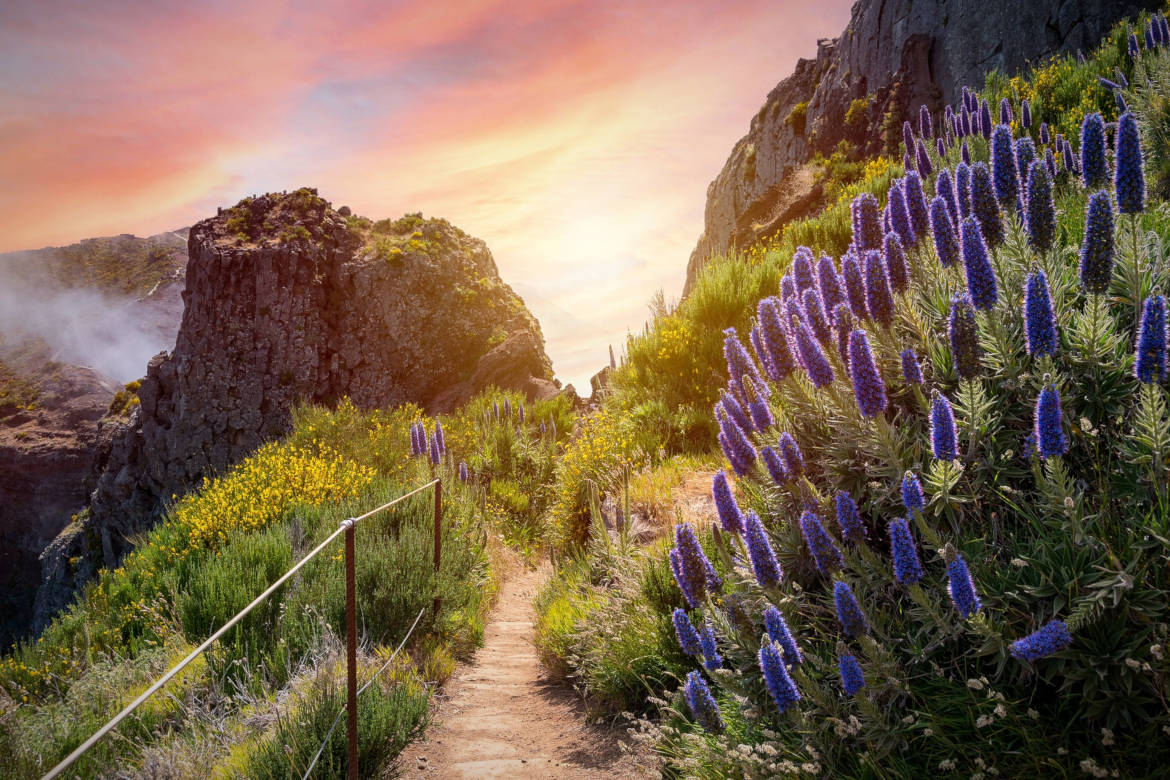Madeira, Portugal’s second-largest island, is a true Atlantic paradise known for its dramatic cliffs, lush forests, and vibrant culture.
Located in the Madeira Archipelago, this island is famous for its breathtaking landscapes, rich history, and welcoming atmosphere.
Often called the “Pearl of the Atlantic,” Madeira Island offers an exceptional blend of adventure, relaxation, and Portuguese charm, making it a must-visit destination for travelers seeking nature, gastronomy, and outdoor activities.
Table of Contents
Geographical Marvels
Madeira spans 741 km² (286 sq mi), making it the second-largest island in Portugal after São Miguel.
Nestled about 1,000 km (620 mi) southwest of mainland Portugal, Madeira Island boasts a stunningly diverse landscape shaped by its volcanic origins.
Towering mountains, deep valleys, and coastal cliffs define the island, with Pico Ruivo, its highest peak at 1,861 m (6,106 ft), offering breathtaking panoramic views.
One of Madeira Island’s most striking features is Cabo Girão, one of the highest sea cliffs in Europe, standing at 589 meters (1,932 ft).
The island’s renowned Laurisilva forest, a UNESCO World Heritage site, covers much of its interior and is home to unique flora and fauna.
Portugal’s 5 Largest Islands
| Island | Area (km²) | Area (sq mi) | Location |
|---|---|---|---|
| São Miguel | 744 | 287 | Azores Archipelago |
| Madeira | 741 | 286 | Madeira Archipelago |
| Pico | 445 | 172 | Azores Archipelago |
| Terceira | 400 | 154 | Azores Archipelago |
| Faial | 173 | 67 | Azores Archipelago |
Cultural Tapestry
Funchal, the capital of Madeira, serves as the island’s cultural and economic center.
This charming city, founded in the 15th century, blends historical architecture with modern conveniences.
Landmarks such as the Sé Cathedral, built in the Manueline style, and the bustling Mercado dos Lavradores, filled with local produce and handicrafts, showcase Madeira’s rich heritage.
The island also has deep maritime connections, having been an important stop during Portugal’s Age of Exploration.
Visitors can learn about its seafaring past at the Museu de Arte Sacra or explore the legacy of Christopher Columbus, who lived on the nearby island of Porto Santo.
Biodiversity and Conservation
Madeira Island is a haven for biodiversity, with its unique Laurisilva forest providing habitat for endemic species like the Madeira firecrest and the rare Madeiran orchid.
The surrounding Atlantic waters are equally rich, home to dolphins, monk seals, and a variety of fish species.
The island’s commitment to conservation is evident through its numerous protected areas and sustainable tourism initiatives.
The Madeira Natural Park and Garajau Marine Reserve help preserve the island’s natural beauty and delicate ecosystems for future generations.
Gastronomic Delights
Madeiran cuisine is a delightful fusion of Portuguese traditions and local ingredients.
A must-try dish is “Espetada,” skewered beef seasoned with garlic and bay leaves, often cooked over open flames.
The island is also famous for its seafood, including black scabbard fish, often served with banana.
One of Madeira Island’s most famous exports is its fortified wine, Madeira wine, which has been produced for centuries.
Visitors can explore historic wine cellars in Funchal, such as H. M. Borges, to learn about the aging process and enjoy tastings.
Additionally, “Bolo do Caco,” a traditional garlic bread, and “Poncha,” a rum-based citrus drink, are local favorites that offer a taste of the island’s rich culinary heritage.
Adventure and Recreation
Madeira Island is a dream destination for adventure seekers.
Its renowned “Levada” hiking trails follow ancient irrigation channels through forests, tunnels, and mountain ridges, offering breathtaking views.
The Vereda do Areeiro trail, connecting Pico do Areeiro to Pico Ruivo, is one of the island’s most scenic and rewarding hikes.
The island’s coastline provides opportunities for thrilling activities such as paragliding, surfing, and canyoning.
Diving enthusiasts can explore underwater caves and vibrant marine life, while boat tours offer whale and dolphin-watching excursions.
For a more relaxed adventure, the traditional wicker toboggan ride from Monte to Funchal provides a unique and exhilarating experience.
Best Things to Do on Madeira Island
How to Get to Portugal’s Second-Largest Island
Traveling to Portugal’s second-largest Island is convenient, with direct flights from several European cities and seasonal routes from North America.
Cristiano Ronaldo International Airport in Funchal serves as the main gateway to the island.
Once on Madeira Madeira Island, a well-maintained road network and public transportation options make exploring the island easy.
Renting a car allows visitors to discover hidden gems at their own pace.
Madeira Islands Ferry Tickets
When to Visit Madeira Island
Madeira Island enjoys a subtropical climate, with mild temperatures year-round.
Average temperatures range from 16°C (61°F) in winter to 26°C (79°F) in summer, making it an ideal destination at any time of year.
The island’s lush greenery is maintained by moderate rainfall, primarily in the winter months.
One of the best times to visit is during the Madeira Flower Festival in spring when the island bursts into vibrant colors.
The New Year’s Eve fireworks in Funchal, one of the largest in the world, also attract visitors from around the globe.
Why Visit Portugal’s Second-Largest Island
Madeira Island’s diverse landscapes, rich history, and unique culture make it an unforgettable destination.
Hike through ancient forests, explore charming coastal villages, or indulge in local delicacies — whatever you choose, the island’s beauty will captivate you.
From its towering cliffs and stunning botanical gardens to its vibrant capital city and thrilling outdoor activities, the second-largest island in Portugal offers something for everyone.
Whether seeking relaxation or adventure, this Atlantic gem promises a truly remarkable experience that will leave visitors enchanted and longing to return.
